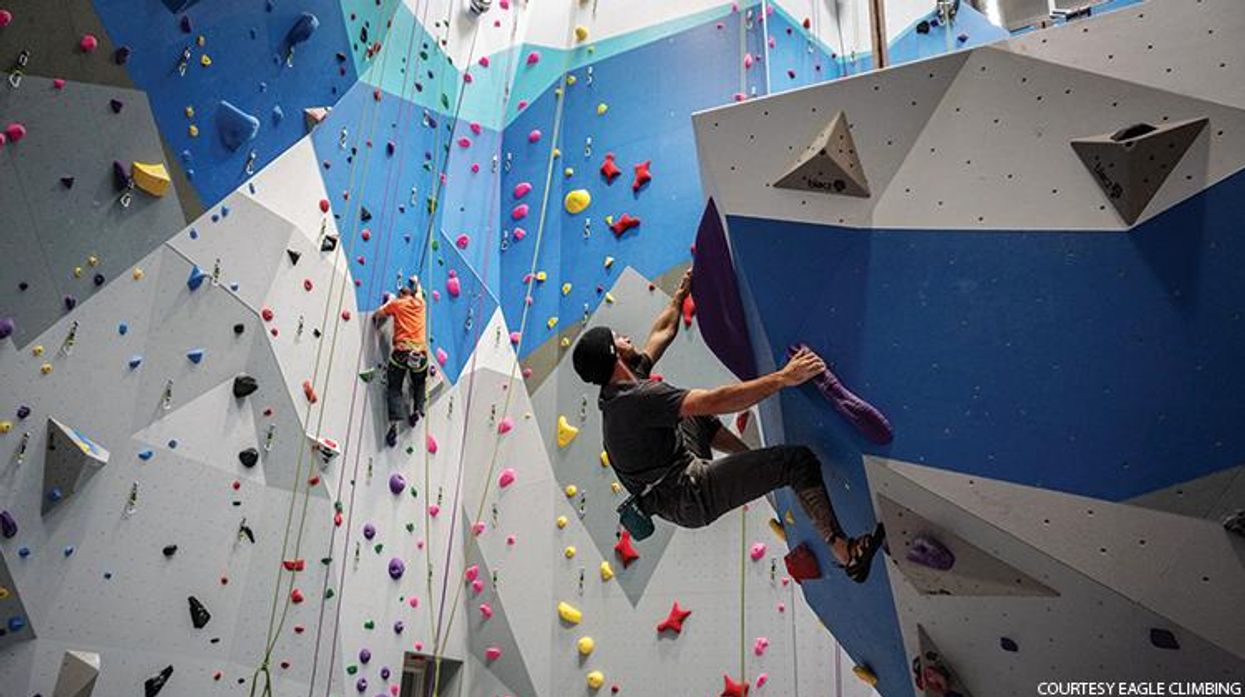Print Issue
These LGBTQ+ Climbers Are Reaching New Heights

No matter how high you go, the sport of scaling rock or indoor walls builds confidence.
September 15 2022 4:00 AM EST
By continuing to use our site, you agree to our Privacy Policy and Terms of Use.

No matter how high you go, the sport of scaling rock or indoor walls builds confidence.
When Megan Carter moved to Colorado several years ago, her partner at the time was an avid climber and tried to throw her into the sport. Carter found herself atop a teetering stone arch in the wilderness. She wanted to cry.
“I was super afraid of heights, totally mortified,” recalls Carter, who is now a climbing coach and the brainchild behind Queer Climbing Night at her local gym, Eagle Climbing + Fitnessin Eagle, Colorado. “It was something totally out of my comfort zone. Also, at that time I saw the climbing community as unapproachable and, as a queer woman, not very welcoming. I saw it as a lot of bros and people trying to prove themselves.”
A climber scales a natural outdoor wall
A couple of years later, she gave climbing another try. As it turned out, all she needed was someone she could trust to show her the way.
“I think whether it’s checking out a queer climbing night, signing up for a class at your gym, or creating a relationship with an instructor or friend who can guide you into the sport, it comes down to trust,” she says. “Showing up at a gym by yourself can be really intimidating. Having that Yoda take you through and show you around is huge.”
A number of climbing gyms throughout the country offer queer climbing events at least once a month. Typically, the events draw a broad variety of skill levels and deliver a community atmosphere.
“We’ve had people who had never climbed before to people who spend every other day at the gym,” Carter says of Eagle’s Queer Climbing Night. “You see this mentor-type relationship develop. You see people meet for the first time and then come back and take a lead class together. The whole point is to build community.”
In addition to nurturing relationships with others, climbing fosters a powerful sense of self-trust and reliance. Nearly every aspect of the sport serves as a metaphor for confidence-building and self-growth.
After all, it’s an endeavor through which you always find yourself facing a wall. The handholds and footholds used to work your way up are literally called “problems.” No matter how far you go, or which route you choose, you are overcoming problems and taking yourself to a higher place.
Handholds are viewed as “problems” to overcome
“You learn not only to trust other people but learn to trust yourself and the equipment,” Carter says. “With the kids I coach, that’s one of the biggest mental blocks — trusting that the rope has them, that the harness will catch them, that the holds won’t fall off of the wall. For new climbers, the common denominator is trust. You learn to trust your gear and trust yourself.”
Another barrier to climbing is the perception that it requires an enormous amount of fitness and strength.
“The misconception is that you need this tremendous upper body strength to be successful,” says Eagle Climbing owner and operator Larry Moore. “Really, we use our legs, our whole skeletal systems to propel us up the walls. People with bigger body sizes think they might not be able to do it, but it can be achieved by everyone. There are so many different layers to success in climbing.”
The recommended path to entering the sport is via an indoor experience at the gym, whether it’s a community event, class, or simply going with a friend for an hour of dabbling on the bouldering wall. From there, familiarity and confidence develop and oftentimes, opportunities to take one’s skills outdoors.
“A lot of what is taught in the gym certainly transfers to outdoor climbing,” Carter says. “The style and level of difficulty are different for every outdoor climb and they’re not standard like what you see in a gym. What’s cool about outside climbing is it takes everything learned in a gym — how to belay, lead climb, and use your gear — and forces a person to heighten their awareness beyond those pieces. All the things that are controlled in a gym are not controlled outside.”
Climbers at Eagle Climbing + Fitness
Whether indoor or outdoor, taking the first steps in climbing is not as challenging as one would think. Once you reach those first holds, going above and beyond is not only natural and intuitive but strengthening in every way, physically and mentally.
“The point is not to go super fast. The point is not to get to the top of the wall. Building trust, developing a sense of community, self-confidence, and self-efficacy, those are the most valuable things to get out of climbing,” Carter says.
Numerous climbing gyms nationwide offer queer community events, including every first Thursday of the month at Valley Rock Gym in Corvallis, Oregon, once a month on Sundays at Adventure Rock gyms in Wisconsin, and at several Central Rock Gym locations across the east coast, including every second and fourth Fridays in Manhattan and on fourth Fridays in Hadley, Massachusetts. Also, Queer Climbing Collective posts monthly info about community climbing events and is a great resource for anyone and everyone interested in climbing.